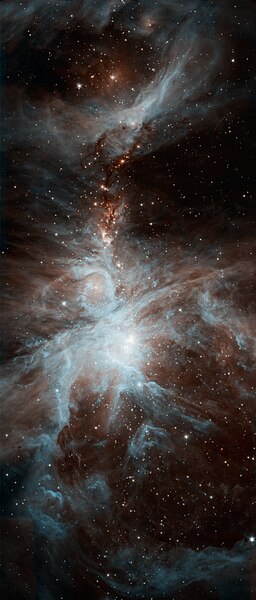Податотека:Spitzer's Orion.jpg

Големина на овој преглед: 256 × 600 пиксели. Други разделности: 102 × 240 пиксели | 205 × 480 пиксели | 328 × 768 пиксели | 437 × 1.024 пиксели | 2.171 × 5.085 пиксели.
Изворна податотека (2.171 × 5.085 пиксели, големина: 1,44 МБ, MIME-тип: image/jpeg)
Историја на податотеката
Стиснете на датум/време за да ја видите податотеката како изгледала тогаш.
| Датум/време | Минијатура | Димензии | Корисник | Коментар | |
|---|---|---|---|---|---|
| тековна | 12:31, 10 април 2010 |  | 2.171 × 5.085 (1,44 МБ) | Originalwana | {{Information |Description={{en|1=A colony of hot, young stars is stirring up the cosmic scene in this new picture from NASA's Spitzer Space Telescope. The image shows the Orion nebula, a happening place where stars are born. The young s |
Употреба на податотеката
Податотекава се користи во следнава страница:
Глобална употреба на податотеката
Оваа податотека ја користат и следниве викија:
- Употреба на ba.wikipedia.org
- Употреба на bn.wikipedia.org
- Употреба на crh.wikipedia.org
- Употреба на cv.wikipedia.org
- Употреба на el.wikipedia.org
- Употреба на en.wikipedia.org
- Употреба на fa.wikipedia.org
- سحابی شکارچی
- ویکیپدیا:نگارههای پیشنهادی/ستارهشناسی
- ویکیپدیا:نگاره روز/اکتبر ۲۰۱۳
- کاربر:MMjex/نگارههای برگزیده
- ویکیپدیا:گزیدن نگاره برگزیده/مه-۲۰۱۳
- ویکیپدیا:گزیدن نگاره برگزیده/Spitzer's Orion.jpg
- الگو:نر/2013-10-30
- الگو:نر محافظت شده/2013-10-30
- بحث کاربر:MMjex/بایگانی ۱
- ویکیپدیا:نگارههای برگزیده/نگاه به فضا
- Употреба на fr.wikipedia.org
- Употреба на hu.wikipedia.org
- Употреба на is.wikipedia.org
- Употреба на it.wikipedia.org
- Употреба на ko.wikipedia.org
- Употреба на krc.wikipedia.org
- Употреба на lbe.wikipedia.org
- Употреба на my.wikipedia.org
- Употреба на no.wikibooks.org
- Употреба на os.wikipedia.org
- Употреба на pl.wikipedia.org
- Употреба на ro.wikipedia.org
- Употреба на ru.wikipedia.org
- Употреба на ru.wikinews.org
- Употреба на sah.wikipedia.org
- Употреба на sr.wikipedia.org
- Употреба на uk.wikipedia.org
- Употреба на vi.wikipedia.org
- Употреба на xal.wikipedia.org
- Употреба на zh.wikipedia.org



